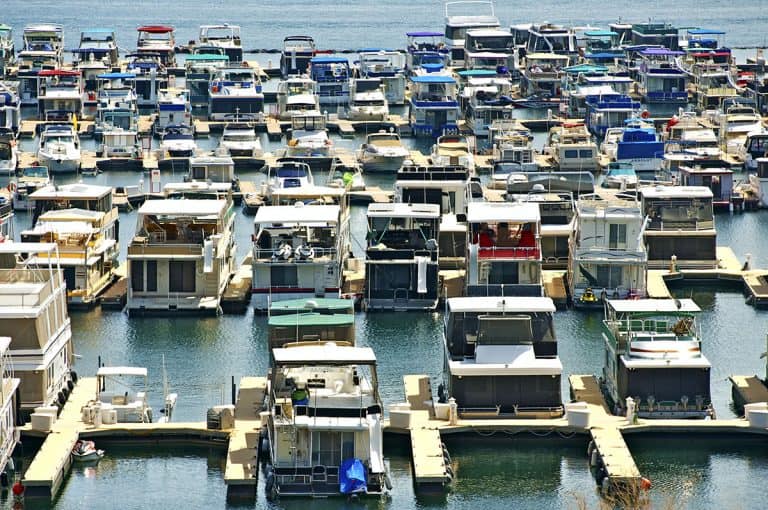How Much Weight Can A Houseboat Hold?
Living on a houseboat comes with a unique set of challenges. One of the biggest is living space limitations, and how much weight a houseboat can hold. Keeping your home afloat isn’t something most homeowners need to consider, but most houseboat residents sure do.
The weight capacity of houseboats varies depending on the size of the houseboat. A weight limit is assigned by the manufacturers of the boat. If this information is not available, you can estimate its carrying capacity by calculating the boat’s displacement.
In this article, we will go through a few rules of thumb to calculate carrying capacity. We will also go through how you can more accurately use displacement to calculate not only your boat’s weight but also how to assess its capacity for additional weight.
A Rule of Thumb re. Weight Limit
Any boat twenty feet or longer must have a label on it, showing the weight capacity of the boat. However, many houseboats do not fall into that range.
If you haven’t yet bought a houseboat, then the easiest way to know the weight limit is to be sure to purchase one that has the appropriate capacity label, regardless of its length.
But, if that ship has already sailed (haha), and your boat doesn’t have the required labels, then this is the formula used by the US Coast Guard that will give you a good estimate of how many people your boat can hold:
Carrying capacity = (boat length in feet x boat width in feet) / 15
If you’re factoring in the average weight of 150 lbs. per person, you can use this formula to estimate the overall weight limit of your boat
Stay well within the calculated results of the formula above and you should be safe.
Displacement: A more Exact Weight Capacity Calculation
Displacement is an essential part of the equation that is used to determine how much weight a boat can hold. Your boat’s weight is equal to the weight of water than the boat displaces.
Displacement is determined by the volume of the hull, although other, minor, factors are involved as well. Such as saltwater versus freshwater, since saltwater weighs more than the same amount of freshwater.
Unless you’re building your houseboat from scratch, determining the exact displacement is difficult because you have to rely on some assumptions regarding the boat’s construction. It is, however, fairly easy to calculate a reasonable estimate.
By calculating the displacement of a boat, what you really calculate is the volume of water that the boat “pushes away” when placed in that water. The formula is somewhat complicated, but this calculator makes is very easy. All you need to know is your boat’s width, length, and its draft (depth of hull in the water).
The cool thing about calculating displacement is that you can easily calculate the weight of anything that you add to, or remove from, the boat based on how it affects its draft.
Let’s say a 8 feet wide and 25 feet long houseboat has a draft of 12 inches before you move your furniture on to the boat. According to the above-mentioned calculator, that means your boat’s current displacement is 12,500 lbs.:

After you have moved the furniture, draft has increased to 13 inches and displacement is now 13,542 lbs.:

That means your furniture weights 13,542 – 12,500 = 1.042 lbs.
If you are unsure how much additional weight can be safely added to the boat, you can determine the maximum safe draft and then calculate how much extra weight that would take to reach.
Say the maximum safe draft on our 8 ft by 25 ft boat is 15 inches. According to the calculator, that would mean a total displacement of 15,625 lbs.:

Considering that my boat (with furniture) currently weights 13,542 lbs, that mens it can carry an additional 15,625 – 13,542 = 2,083 lbs.
For more detailed info on how to calculate displacement, take a look at this guide (.doc file).
How Much Does a Houseboat Weight?
One rule of thumb is that you should not have more weight on your boat than your boat’s weight. This is also true for smaller boats. For instance, if a regular pontoon boat weighs 2,200 lbs, it should not hold more than 2,200 lbs of additional weight unless stated otherwise by the manufacturer.
Most houseboats weigh 300 to 550 lbs. per foot in length. That means a typical 40-foot houseboat weighs between 12,000 and 22,000 with a median of 17,000 lbs.
| Lenght | Low Weight | High Weight | Median Weight |
|---|---|---|---|
| 25′ | 7,500 lbs. | 13,750 lbs. | 10,625 lbs. |
| 30′ | 9,000 lbs. | 16,500 lbs. | 12,750 lbs. |
| 35′ | 10,500 lbs. | 19,250 lbs. | 14,875 lbs. |
| 40′ | 12,000 lbs. | 22,000 lbs. | 17,000 lbs. |
| 45′ | 13,500 lbs. | 24,750 lbs. | 19,125 lbs. |
| 50′ | 15,000 lbs. | 27,500 lbs. | 21,250 lbs. |
| 55′ | 13,500 lbs. | 30,250 lbs. | 23,375 lbs. |
| 60′ | 18,000 lbs. | 33,000 lbs. | 25,500 lbs. |
The safe additional weight on your houseboat should be less than the boat’s own initial weight. While many houseboats can carry a lot more, do not exceed the boat’s own weight, unless you are sure this is within its limits.
This is not as simple as making sure you do not have too many people on board. You have to take into account a number of other things: fuel, furniture, and even things as small as gadgets and food. The little things can quickly add up.
Also, different manufacturers build houseboats with various capabilities. As the weights listed above are averages, it is possible that your particular houseboat can hold more or less weight than that.
With all that said, and with the weights listed above, a careful rule of thumb for a 25-foot boat would be to make sure you do not exceed an additional weight of 7,500 lbs. And the safest weight capacity to stay under for a 44-foot boat would be around 13,000 lbs., and so on.
As mentioned earlier, the exact numbers depend on the manufacturer of your houseboat, what type of houseboat it is, displacement, and what comes with your houseboat.
Different Types Of Boats and Weight Capacity
There are a number of types and styles of houseboats. Each has its own unique specifics, including weight and weight capacity. One of the biggest distinctions between houseboats is whether they are stationary or mobile.
Stationary houseboats are meant to stay in one place. They can be just off of the shore, or they can be in the middle of a body of water, safely anchored to the bottom.
Mobile houseboats, as you have probably already realized, are mobile. They are equipped with sails or motors that allow them to maneuver around the water.
If you are in the market for a houseboat, the type you choose is mainly up to you. Of course, the cost may affect your decision, but in the end, it all falls on your preference.
There are a number of stationary and mobile houseboats to choose from. Some we have provided information for below.
Floating Homes
Hence the name, floating homes are generally stationary. Most of the time, they are located just offshore, close enough to walk on land from the front door. However, they are very popular, particularly among retired people looking to spend time on the water.
If you are looking for a houseboat but do not want to have to deal with driving it around, a floating home can be a great choice for you.
Floating homes usually have a set width at twenty feet, but the length can range anywhere from thirty to one hundred feet. It is not uncommon to see a very long floating home that can fit a medium to large-sized a number of family members.
Floating homes are generally able to handle a little bit more weight because they’re not meant as seafaring vessels. However, loading them up well beyond maximum capacity is still not recommended.
Pontoon Boats
Pontoon houseboats are probably one of the houseboat types you are most familiar with. They can be seen all over lakes and oceans. While they typically come equipped with a motor, many people who own pontoon houseboats keep them docked at a marina.
Because of their size – and the size of any houseboat, for that matter – pontoon boats are generally not manufactured for speed, so if you were to take a boat like this out on the water, it might be best for a sunset cruise when most of the other water traffic has called it a night.
Depending upon the make and model of a pontoon boat, its dimensions might be anywhere from a width of eight to ten feet and a length of around twenty-two feet. They are quite maneuverable and can be taken out – in the right conditions – with no problem.
Pontoon houseboats, however, are not made to handle much weight at all. The weight quite a bit on their own, so owners must be very mindful of what they choose to bring on board.
Canal Boats
Canal boats are very popular in European countries like the UK and Netherlands. Similar to floating homes, they generally stay in calm water – in this case, canals.
Amsterdam is known for its beautiful canals filled with tourists and natives looking for fun. Canal boats can be a great way to live directly in the center of all the action around you.
Canal boats usually stay docked or tied up to the side of the canal, but some are equipped with low-power motors or paddles that allow for a slow and steady promenade down the canal.
Canal boats are around six feet in width because they are meant to safely flat down narrow waters. However, their lengths can range from twenty feet to upwards of seventy feet.
Canal boats that are never moved will be able to hold more weight than those used for transportation. Although, as canal boats remain in calm waters and travel at low speeds, they can carry quite a lot of weight relative to their displacement.
Yachts
Yachts, along with pontoons, are also likely very familiar boats to you. While they are typically the most expensive type of houseboat, their price comes with high rewards.
Their shape and motors allow for a drive on the water almost as easy as a regular ski boat, but with the benefit of a lower cab equipped with luxurious beds, furniture, and appliances.
Yachts are great houseboats for those who enjoy exploring open waters while also having the option of sunbathing on the deck or spending the day relaxing in the cabin.
Yachts might typically be about ten feet in width with a length of around thirty or forty feet. They should not be too much more complicated to drive than a standard boat, but their size might add a bit more difficulty.
As yachts are exposed to rough waters, their draft should be lower, meaning they cannot safely carry as much weight as other types of boats.
Sailboats
Sailboats are regarded as one of the most adventurous types of mobile houseboat living. Steered by the wind, sailboats have large sails connected on them and usually a small cabin below.
They are usually not too big, although length ranges anywhere from sixteen to fifty feet or more. Their width is less than ten feet.
The dimensions of a sailboat, along with the fact that they are operated by the wind, calls for extreme strategic knowledge of how to operate such a houseboat.
Some sailboats do come with motors, but the sailing part is what it is all about. Whether you are staying close to the shore on a lake or exploring the vast, open ocean, sailboats are a great leisure boat that can be used for recreational or living purposes.
Like motor yachts, sailboats are exposed to rough waters and should not carry as much weight as other types of boats of similar displacement
Regular Household Items and the Weight of Your Houseboat
Space is clearly an issue when living on a houseboat, no matter what the size is. There’s simply not enough square footage or enough room in the weight limit. Here are some common household necessities that are on the heavier side, so considering alternative options may be necessary.
Couch (weights about 300 pounds)
There is a high chance your houseboat will already have come with furniture like sofas or chairs. Adding more to that is likely irrelevant. You might want a possible sitting room available, but sometimes small sacrifices like this can be made. An additional couch is that much more weight.
If you are going for comfort, you might be out of luck, but a few folding chairs can work just as well.
Bed (weights about 180 pounds)
The only way you are going to have a bed in your houseboat is if your boat comes with one. Bringing your own bed is not going to work out. Many houseboats come with a small master bedroom, so this may not be a problem for you.
If you find that you need more sleeping space, you might consider bringing inflatable mattresses or cots, which weigh much less than a full bed and bed frame.
Refrigerator (weights about 250 pounds)
Some houseboats might come with a fridge. Some might not. You might just have a little ice maker built-in that provides at least a little bit of storage space. If you do not have a fridge, bringing an ice chest or cooler can work just as well also.
Bathtub (weights about 350 pounds)
If you think about it, a bathtub is not going to be extremely necessary on a houseboat. If anything, your boat might come with a shower, but bathtubs are not very relevant. If you want to soak in some water, spend some time in the water that your houseboat is floating on.
Safety First When Considering How Much Weight a Houseboat Can Hold
It is true that much of the weight added to your boat depends on how many people are aboard. However, in terms of weight capacity, people are not the only factor. As mentioned, even the smallest things will add to the weight your houseboat has to support.
You might have grand plans of adding everything you want into your houseboat, but the fact of the matter is, you will likely have to be a little picky. Of course, you want your houseboat to be homey, welcoming, and well-furnished, but your safety is more important than luxury.
The last problem you want to face is the possibility that your houseboat is unable to carry its load, especially if you are not docked.
Houseboat living is such a neat alternate method of living, and when necessary precautions are taken, you can be sure to make the most of your opportunity. There are few things as rewarding as spending the day out in the sun being rocked by the waves of the ocean or having a candlelight cookout in the middle of the lake.
Other Factors that Can Impact a Houseboats’ Weight Capacity
While ensuring the correct weight capacity is very important, there are also numerous other factors you must consider when taking care of your houseboat. We will not go into too much detail, but here are a few other things to think about:
Fuel
Making sure you have enough gas – if your houseboat is mobile – is obviously one of the top things to know. You do not want to find yourself stranded in the middle of a body of water because you forgot to refuel. A houseboat that’s low on fuel cannot hold as much as a fully gassed one.
Basic Boating Knowledge
Even driving the smallest boat requires the ability to maneuver and take care of your boat. With houseboats, the requirement is even more necessary because you are dealing with such a large piece of machinery.
This does not just apply to mobile houseboats; if you live in a stationary canal boat or floating home, it is still important to be aware of the precautions needed to maintain buoyancy, cleanliness, and functionality.
Owning a houseboat and not being aware of the weight limits is irresponsible and a recipe for disaster.
Boat Condition
Speaking of cleanliness and functionality, you do not want your boat to be poorly taken care of. Regular cleaning and technical checks will help ensure that your boat is in its best condition.
An older boat that hasn’t been maintained can have weak spots and damage that can lead to diminished weight capacity.
Water Condition
Another important thing to note is the type of water your houseboat is going to be located on. Oceans, rivers, and lakes all have different common wind and wave conditions. Knowing these usual conditions is important to be able to navigate the waters safely and with the right type of houseboat.
Naturally, a boat can handle more weight when it’s in calmer waters. However, it’s still best to make sure everything is secure, even if the waters are calm, and you’re well under the weight limit.
Takeaway
Owning a houseboat is a joy. And no matter what type of houseboat you invest in, your main goal should be to enjoy the thing with which you have spent money on. However, one of the biggest problems you might face involves making sure the people and materials on your boat do not exceed regulated weight capacity.
At the end of the day, your houseboat is your houseboat. How you decorate your boat, who you invite on your boat, and the methods you use to take care of your boat all rely on you. In a way, the type and style of the houseboat you have might be a part of you. It is important to make how you want it.






